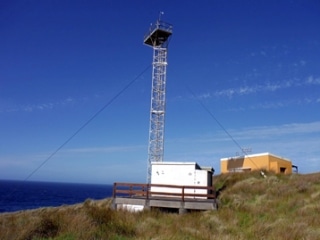Jun 22 2016
The atmospheric concentration of carbon dioxide (CO2) measured at Amsterdam Island, in the southern Indian Ocean, was found to exceed the symbolic value of 400 ppm1, or 0.04% in May this year. The recorded concentrations of CO2 at the Amsterdam Island research station are globally considered to be the lowest (not taking into account the seasonal cycles), because of the remoteness of the island from anthropogenic sources. During the winter of 2012/2013, the 400 ppm threshold was already crossed in the Northern hemisphere.
 Atmospheric composition observatory on Amsterdam Island. © O. Llido
Atmospheric composition observatory on Amsterdam Island. © O. Llido
There also seems to be a rapid increase in the CO2 present in the air, and this has been annually shooting up to more than 2 ppm over the past four years. For the past 35 years, the data has been recorded at the Amsterdam Island research station by the French national observation service ICOS-France at the Laboratoire des Sciences du Climat et de l'Environnement (LSCE, CNRS / CEA / UVSQ)2, with the support of the Institut Polaire Français Paul-Emile Victor (IPEV).
Amsterdam Island is one of the 30 stations in the WMO3 global network for observing the composition of air, and the region is also treated as a reference site for atmospheric chemistry in the Southern hemisphere. The measurements performed here are used to control variations in greenhouse gases like N2O, CH4, and CO2 and also to quantify the role of Southern Ocean as a carbon sink in a much enhanced manner. This is carried out at an observatory owned by the French national observation service ICOS-France4, currently organized by Ramonet and Marc Delmotte, researchers at the LSCE (CNRS / CEA / UVSQ). The observatory is capable of drawing on expertise from LSCE's, and has received support from IPEV since its establishment in 1981. Civic service volunteers are responsible for maintaining the facility.
Fort the past 35 years, consistent measuring of the CO2 concentration in the atmosphere has been executed. For the very first time, it went beyond 400 ppm in May 2016. The CO2 value that was recorded by the observatory highlighted extremely less seasonal variation (<1 ppm), and this refers to the fact that the increase observed is symbolic of the long-term trend.
CO2 concentrations have increased from 339 to 400 ppm (+18%) since 1981, and this is considered to be an average increase of 1.75 ppm annually. Researchers have also recorded higher increase rates over the past years. There seems to be a growing increase of CO2 in the atmosphere because of the yearly increase rate analyzed, which indeed was 1.30 ppm in the 1980s, and is currently more than 2 ppm every year since 2012.
In winter 2012/2013, the 400 ppm value was already found to exceed at monitoring stations located in the Northern hemisphere. Hence, going beyond the 400 ppm threshold at Amsterdam Island highlights the fact that this value has been obtained over the entire planet.